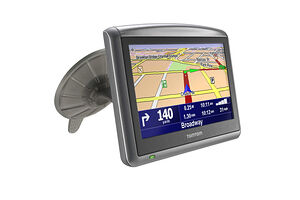- Touch screen (Touch screen)
If the device has an touch screen, the user can navigate control the device (through menus, look up directions, browse, etc.) by touching the screen.
- Display resolution (Display resolution (width x height))
Resolution is the number of horizontal pixels times the number of vertical pixels of the display.
- Built-in antenna (Built-in antenna)
If the device has an internal antenna built-in, the use of an external antenna is not obligatory.
- External antenna support (Support for external antenna)
External antenna often offers better reception than the internal GPS antenna.
- Bluetooth (Bluetooth support)
Via Bluetooth the GPS can be connected to another Bluetooth device for data transfer. The connection can be used e.g. to transfer location data from the GPS to a mobile phone, PDA, or PC.
- Map storage medium (Main storage medium for maps)
The storage used for map data can be either internal (flash or HDD) or external (a memory card, CD or DVD). A navigator can also support more than one storage methods, which eases the upload of new maps. For example, you could store the map of your home area on the internal storage medium, and when you decide to make a road trip to a foreign country, use an external memory card to upload the map of the destination.
- DGPS support (Differential GPS support (DGPS))
DGPS (Differential Global Positioning System) is a method of improving the accuracy of GPS navigator by adding a (fixed) local reference station to augment the information available from the satellites. It also improves the integrity of the whole GPS system by identifying certain errors.
- Internal storage (Internal storage size)
The amount of space available on the internal storage medium can vary greatly, but so does the need for it. If the navigator is needs only to store the map data, lesser space is required. But if the device is used to store many maps or especially entertainment content (e.g. music, photos or video), can extra space be of use.
- USB (USB or USB2 connector)
The most common use of the USB connector is to connect the GPS to a computer. This allows the computer to access the GPS for system updates, map uploads, and other possible data transfer (e.g. music or photos).
- Screen format (Screen format)
Screen format of the display is expressed as the width to height ratio (width:height). Often used formats include the standard 4:3 and the so called widescreen (16:9).
- TMC support (Traffic Message Channel support (without an add-on))
Traffic Message Channel (TMC) is a technology for delivering traffic and travel information to drivers. The system is in use in many European countries. When integrated into a navigation system, TMC gives the driver the option to take alternative routes to avoid traffic incidents.


